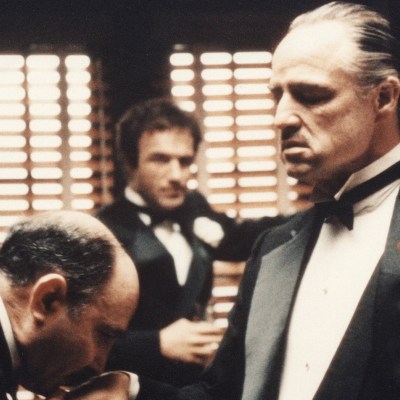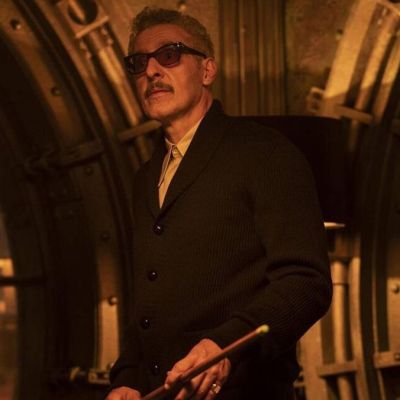The Godfather: The Three Battles That Decided a Classic’s Fate
On its 50th anniversary, it’s a wonder that the film version of The Godfather even exists at all.
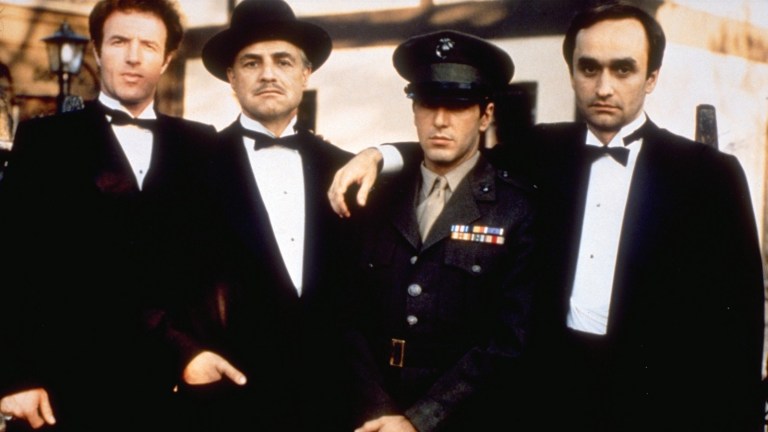
“There’s an old adage in the business… unhappy sets make great movies.”
That was spoken by producer Albert S. Ruddy, and he should know. Ruddy was the producer on The Godfather, Francis Ford Coppola’s adaptation of Mario Puzo’s bestselling novel that is renowned as one of the greatest films of all time. But making a masterpiece like this certainly did not come easily.
Ruddy’s comment is recounted in author Mark Seal’s recently published book, Leave the Gun, Take the Cannoli, an exhaustive and fabulously entertaining look back at the making of The Godfather through the eyes of many of those who were there. The film itself celebrates its golden anniversary this week (it was released on March 24, 1972) and the studio, Paramount Pictures, has pulled out all the stops.
The Godfather was reissued earlier this month in theaters in a brand-new restoration, enabling many (including this writer) to see it for the first time ever on the big screen while all three of the films–including both cuts of The Godfather Part III–were given a fresh restoration and are now available for the first time in 4K Ultra HD in a new Blu-ray package that includes several new bonus features and all the legacy content and exhaustive making-of documentation from previous home releases.
Incredibly, Francis Ford Coppola only just received a star on the Hollywood Walk of Fame on March 21, 2022, an honor long overdue for the man who not only made the Godfather films but other classics like The Conversation, Apocalypse Now, and Bram Stoker’s Dracula (fun fact: Coppola’s close friend, George Lucas, still does not have a star embedded in the fabled sidewalks of Hollywood yet).
And yet all this pomp and circumstance, for a film and a legacy that certainly deserves every accolade afforded it now and over the years, might never have happened. The Godfather was also an exceptionally difficult film to make, despite the clear commercial success of Puzo’s 1969 novel, and battles were fought over nearly every aspect of its production.
As recounted in Seal’s book, perhaps the three biggest were the struggles with the real-life mafia, who threatened to sabotage the film any way they could; Coppola’s fight with Paramount head of production Robert Evans and Charles Bluhdorn, chairman of Paramount parent company Gulf+Western, over the casting of the film; and finally the battle over Coppola himself. The director was certain he was going to get fired during the making of the movie and even had to fend off an attempted coup within the ranks of the production crew. Let’s look at all three.

The Battle with the Real-Life Mafia
Right from the start, the actual mafia–personified by the Five Families of New York City, but stretching across the country and around the world–was against the making of this movie. The organizations collectively known as Cosa Nostra preferred to do their business in the shadows for the most part, and were already unsettled by the detailed accounts found in Puzo’s book, which he famously said he wrote without ever meeting a real gangster.
The mob exerted actual pressure to stop the movie before filming even started. According to Seal’s book and other sources, threatening phone calls, bribe attempts and physical intimidation (such as being followed) were part of it, while some 62 filming locations across the New York City area–where Coppola insisted on filming for authenticity purposes–became suddenly “unavailable” and closed their doors to the production.
“I don’t know if they could have stopped it, [but] I think they would’ve made it very difficult to film it in New York City,” Seals tells Den of Geek about the mafia’s campaign against the film. “There were homeowners and shop owners who withdrew their locations, and the truck drivers were threatening to not work, which could have been a real problem. I mean, they could have done it on a back lot or in another city, but I think that would’ve lost everything. Francis Ford Coppola fought for those two things, doing it in a period of the 1940s and filming it in New York, which is what made it magical.”
The man at the center of the campaign against The Godfather was Joseph Colombo, who was on the surface the head of the Italian-American Civil Rights League. The League was an apparently legitimate organization that protested the stereotyping of Italians as criminals by not just the media but also law enforcement and other institutions. Yet Colombo was also the alleged head of the Profaci (later Colombo) crime family, one of the Five, and his embrace of the spotlight as head of the League was unprecedented for a mafia boss.
“That was an amazing part of the story,” says Seal about Colombo’s involvement with the League and its protests against The Godfather. “He was a crusader for civil rights with the League, and with that organization he really was successful in doing a lot of things. One of those things was stamping out the word ‘mafia,’ which he felt was demeaning. That was the one thing with the film that he wanted not to be used.”
Indeed, after Al Ruddy met with Colombo and agreed to remove the word “mafia” from the screenplay–where it was only used once or twice–things changed almost overnight for the production. “After that deletion, a world of cooperation opened,” adds Seal. “So yeah, he was one of the great characters of the late ‘60s, early ‘70s, before he was shot [at a League rally in 1971]. He was able to do a lot with that organization, so it was an amazing story in itself.”
Ironically, the mafia eventually came to accept and even embrace The Godfather. “For sure they embraced it,” says Seal. “It became part of the folklore, right? I quote one man who said, ‘After seeing the movie, Mario Puzo had to be part of something because how could he get our world down cold?’”
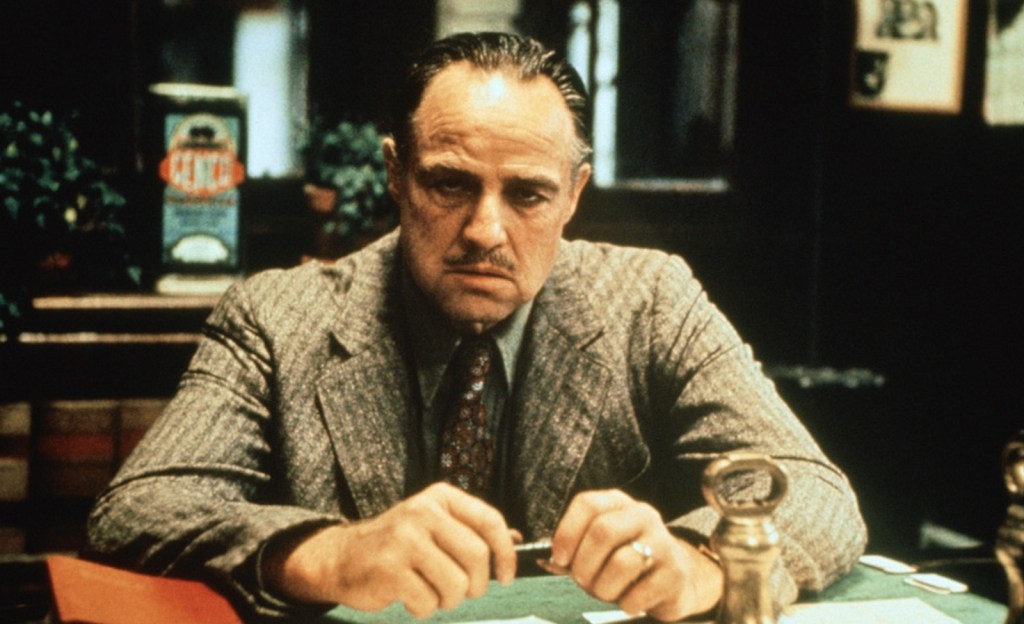
The Battle Over Casting
One of the interesting things about The Godfather is how many members of the cast either had or claimed to have connections to the Mafia or “the boys downtown.” James Caan claimed to have grown up with a lot of wiseguys in Queens. Gianni Russo (who played Carlo, the son-in-law who betrays the Corleone family) alleged that he associated with bosses like Frank Costello and Carlo Gambino while coming up and used some of his connections to land an audition. Singer Al Martino, who played teen idol Johnny Fontane after Vic Damone dropped out, had performed in mafia nightspots for years.
Al Lettieri, who played Virgil “The Turk” Sollozzo–the drug dealing mobster who tries to knock off Vito Corleone–was the actual brother-in-law of a captain in the Genovese crime clan while Richard Castellano, who played Corleone caporegime Pete Clemenza, was said to be the nephew of Gambino family boss Paul Castellano. It’s an assertion that Richard’s sister strongly denied in Leave the Gun, Take the Cannoli (which, incidentally, is the line that Castellano made famous in the film, ad-libbing “take the cannoli” on the spot during filming).
All these cast members added a certain layer of authenticity to the movie whether their alleged connections were real or not. Coppola insisted on casting Italian-Americans in as many roles as possible. But when it came to the biggest parts in the movie, that of Vito Corleone himself and his youngest son Michael, who rises to take his father’s place, the director and the studio clashed vehemently over who should have the parts.
From the start, Coppola wanted Marlon Brando as the godfather and a then-unknown Al Pacino as Michael, the future godfather. “I guess the biggest battle was over Al Pacino,” says Mark Seal. “Robert Evans did not want Al Pacino, but Coppola, every time he said he closed his eyes and saw those Sicily scenes in his head, he saw the face of Al Pacino. He became a star because of that movie.”
Indeed, Pacino had only acted in one film, The Panic in Needle Park, prior to making The Godfather, and was otherwise a little-known New York stage actor. It’s hard to imagine now, considering what big stars they became, but Pacino, James Caan, Robert Duvall (Corleone family consigliere Tom Hagen), and Diane Keaton (Michael’s wife Kay) were all relative unknowns when they were cast in the film.
“They were all actors, but they weren’t known or stars even,” agrees Seal. “Al Pacino had not been seen in a movie, he was a theater actor. The Panic in Needle Park hadn’t been released yet. Robert Duvall and James Caan had done a film with Coppola [The Rain People], so he knew them. Diane Keaton he knew from a television commercial and he thought she would add some lightness to the film.”
While the studio and Coppola fought bitterly over Pacino; they also battled mightily over Brando. Coppola and Puzo both wanted the one-time superstar but Evans, Bludhorn, and Paramount president Stanley Jaffe were adamantly against it, citing a string of box office duds and his reputation for being difficult. Their top pick was Ernest Borgnine. Even Brando himself didn’t want the role at first.
“He said, ‘I don’t want to play a mafia don, I don’t want any part of it,’” says Seal. “But then Puzo had sent him a copy of the book and written him a letter, saying, ‘You’re the only actor who can play the role with the quiet intensity that I believe it deserves.’ So [Puzo] saw it from the beginning, and Coppola saw Brando as well. But he was considered problematic and over-the-hill at only 47… then [Jaffe] gave all these conditions, including that he had to do a screen test, which Brando wasn’t going to do.”
Coppola’s solution was a trick: he told Brando that he wanted to film him for a makeup test, which doubled secretly as a screen test for the Paramount brass to watch. According to legend, Brando pulled back his hair, dabbed a little shoe polish on his upper lip for a mustache, plugged wads of tissues into his cheeks to create jowls, and literally transformed into the Godfather.
“They shot that video of Brando, where he stuffs the Kleenex in his cheeks and becomes Don Corleone,” reports Seal. “But what I didn’t know is that Coppola took that tape immediately to New York and showed it to Charlie Bluhdorn, who was the head of Gulf and Western, Paramount’s parent company, and when he said, ‘Oh my gosh, that’s incredible,’ then everybody else fell in line. The other interesting thing is that tape has just vanished from the face of the earth–nobody knows where it is.”
In the end, Coppola got the exact cast he wanted, although the stress of getting there took a toll on the already beleaguered director. And yet, in some alternate universe perhaps, there’s a Godfather with either Ernest Borgnine, Danny Thomas (!), or perhaps Anthony Quinn as Vito, Ryan O’Neal or Robert Redford as Michael, a fellow named Carmine Caridi (who thought he had the part) as Sonny Corleone, and Jennifer O’Neill or Karen Black as Kay Adams. But would that version have become as iconic as the one we have?
“I don’t know,” muses Seal. “I don’t think it would work as well, because Coppola just envisioned so many aspects of this thing. It was just perfect casting. You can’t imagine anybody but James Caan as Sonny, or Robert Duvall as Tom–just the way he speaks to John Marley. And John Marley too, as the producer, Jack Woltz. I mean, who could do a scene with the horse’s head in a bed the way that he did it? Or Diane Keaton as Kay–the way she looks when that door closes at the end.”
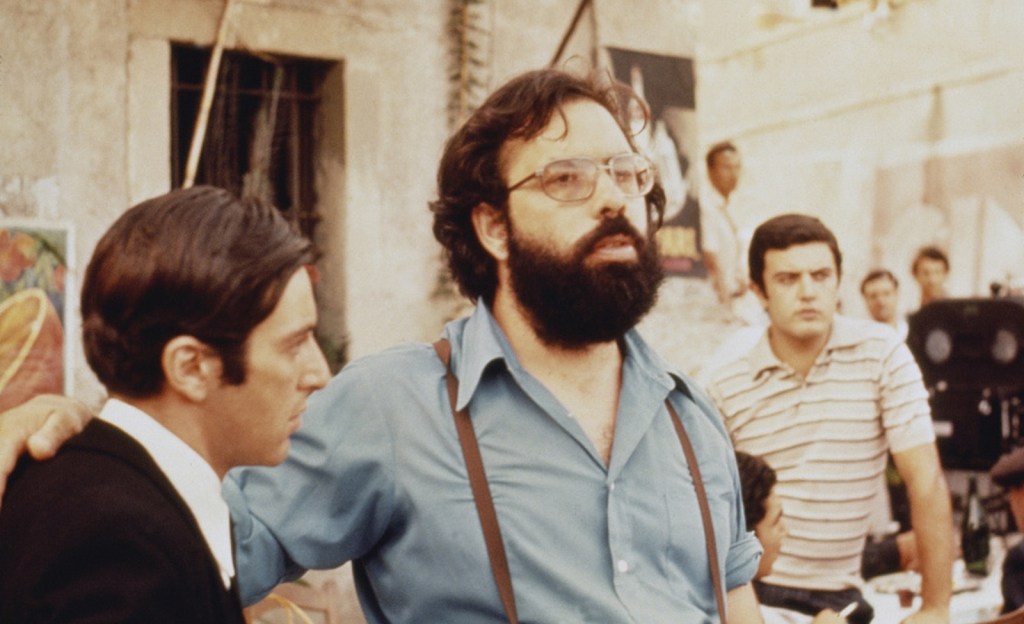
The Battle Over Francis Ford Coppola
Like Brando, Coppola was hesitant to direct The Godfather at first. After directing two flops in a row (Finian’s Rainbow and The Rain People), he retreated to San Francisco with his friend George Lucas and started American Zoetrope, a studio aimed at creating artistic, experimental films with iconoclastic filmmakers that avoided the Hollywood formula and mindset. But the company very quickly ran into financial problems and Coppola’s dream artistic haven was in danger of crashing down.
“He had moved to San Francisco to get away from the big budget blockbuster mentality,” says Seal. “The reason that he did [The Godfather] was, like Puzo, he needed the money, and it was only when his assistant George Lucas, future director of Star Wars, said, ‘Francis, the sheriff’s at the door, do The Godfather and then we can do the kind of films we want to make.’”
However, Coppola did not just want to do a cheap, shoot-‘em-up gangster picture, which had been on the wane at the box office for a long time. He also was not impressed with the pulpy nature of Puzo’s writing when he read the book. But when he looked deeper into it, he saw something else: a story about the subversion of the American Dream, as well as a tragedy about a dying king and his three sons, one of which would step up to succeed the father.
Paramount, however, was still thinking of The Godfather as a fast and dirty, low-budget crime drama, and even wanted to move the story from the 1940s and ‘50s to the present just to save money. The studio offered the picture to esteemed directors like Sergio Leone, Peter Bogdanovich, Arthur Penn, Warren Beatty, and Otto Preminger. All of whom turned it down.
When studio exec Peter Bart finally suggested Coppola, however, the director insisted on keeping the era from the book, and also demanded that as much of the film as possible be shot in New York City, not to mention Sicily for the scenes of Michael’s forced exile there after he kills Sollozzo and the police captain McCluskey. Fortunately, as the book grew in popularity, so did the movie’s budget–although the filming of The Godfather was, by all accounts, an exercise in controlled chaos during which the director was convinced he was going to get the sack during the early stages of production.
First he thought he’d get the axe for his unorthodox casting choices. Then he thought it would be over his choice of Gordon Willis as cinematographer, with the studio execs straining to see what was happening onscreen due to Willis’ brilliant yet darkly lit compositions. The studio also did not like what it was seeing of Pacino in his early scenes, as the actor struggled to find his way into the character.
Meanwhile, a plot was hatched–furtively encouraged by studio VP and “fixer” Jack Ballard, who was sent to watch over the shoot and account for every dime–to overthrow Coppola. The plan was the developed by six crew members, including assistant director Steve Kesten and editor Aram Avakian, who was telling Paramount that the shots he was getting did not match up well enough for him to edit the movie together properly. Although Elia Kazan had been mentioned as a possible replacement, the idea was to get Coppola fired and have Avakian take over the picture.
But Coppola instead fired the conspirators. “He fired them during the week so they couldn’t replace him over the weekend,” says Seal. “But yeah, he had an insurrection on his own set, he had the studio saying, ‘What are these dailies? It’s so dark.’ He battled his cinematographer… Every day he felt like he might be fired, until that amazing scene where Michael shoots McCluskey and Sollozzo in the restaurant. Once they saw that, everybody backed off because they saw the brilliance of that scene.”
Once the classic restaurant scene was shot, Coppola’s job was secure (as was Pacino’s), but that didn’t mean the scuffles ended. Coppola had to wrestle with a relatively short shooting schedule (he asked for 80 days and initially got 53), he had to fight to get the Sicily scenes done, and he also fought Evans over the music–the exec did not like Italian composer Nino Rota’s now-classic score and wanted to replace it with something lighter by Henry Mancini until Coppola threatened to take his name off the film.
The final battle was over the film’s length: Coppola turned in a 175-minute cut while Paramount demanded the film be no longer than two hours and 15 minutes in order to fit as many screenings as possible into theater schedules. So Coppola, who did not have final cut, removed 40 minutes from the movie and screened it for Evans. “You shot a great film–where the fuck is it?” Evans reportedly said to Coppola after the film ended. He then got on the phone to Paramount and allegedly said, “I just ran it at 2:15 and it stinks… do this at 2:15 and I’m walking and you can close the fucking studio.”
Until his death in 2019, Evans would claim a considerable amount of responsibility for the final version of The Godfather that ended up in theaters, a contention that Francis Coppola acrimoniously disputed for years (the two men did not speak for decades, but eventually reconciled). Whatever contributions Evans or others made, there’s no doubt that The Godfather would not exist as it does now without, first and foremost, the original story and indelible characters created by Mario Puzo, filtered through the genius vision of Coppola and embodied by the remarkable cast and crew whom he assembled.
And yet, as Al Ruddy told the Telegraph, “It was the most miserable film I can think of to make…Nobody enjoyed one day of it.” That echoes his comment about unhappy sets, which seems in this case to have proven all too true.
“Al Ruddy said that about the set,” Seal concurs. “And Peter Bart said that the magic of it was that everybody felt like every day might be their last, so they wanted to produce their best work every day. So there was this creative tension that all came together and coalesced into this magnificent film. I think that everybody was fighting for survival… you don’t feel that in the film, but you do feel like everybody’s trying to do their best work, and that’s one of the things that made it great.”
The Godfather Trilogy is out now on 4K Ultra HD Blu-ray.

